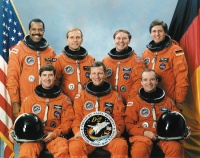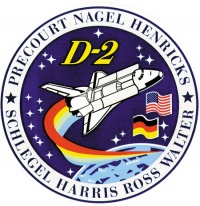STS-55
From The Space Library
 | |
| Organization | NASA-Office of Space Flight (United States) |
|---|---|
| Mission type | Astronomy,Earth Science,Human Crew,Life Science,Microgravity |
| Launch date | April 26, 1993 |
| Launch vehicle | Space Shuttle |
| Launch site | Cape Canaveral, United States |
| COSPAR ID | 1993-027A |
| Inclination | 28.45 degrees |
| Experiments | Here |
| Alternate Names | Spacelab-D2/STS 55,22640 |
| Additional Information | Here |
| PDMP Information | Here |
| Telecommunications Information | Here |
| Data Collection | Here |
| Payload Mass Up | 12185 kg |
| Payload Mass Down | 12210.91 kg |
| Orbiter | Columbia |
| Lift Off Mass | 2,053,992.73 kg |
| Orbiter Weight at Liftoff | 116,023.64 kg |
| Orbiter Weight at Landing | 103,274.09 kg |
| Landed | Concrete runway 22 at Edwards Air Force Base, Calif. |
| Orbits of Earth | 160 |
| Orbital Altitude | 160 nautical miles (184 statute miles) |
Contents |
[edit] Crew
- Commander: Steven R. Nagel
- Pilot: Terrence T. Henricks
- Payload Commander: Jerry L. Ross
- Mission Specialist 1: Charles J. Precourt
- Mission Specialist 2: Bernard A. Harris Jr.
- Mission Specialist 3:
- Mission Specialist 4:
- Mission Specialist 5:
- Payload Specialist 1: Payload Specialist 2: Hans Schlegel, Germany
- Payload Specialist 2: Payload Specialist 1: Ulrich Walter, Germany
ISS/Mir Crew Transport
[edit] Mission
STS-55 was the 54th flight of the Space Shuttle and the 14th flight of Columbia. The STS-55 mission was devoted primarily to the German Spacelab D-2 experiments in life science, microgravity, earth science, and astronomy. The D-2 mission, as it was commonly called, augmented the German microgravity research program started by the D-1 mission. The German Aerospace Research Establishment (DLR) had been tasked by the German Space Agency (DARA) to conduct the second mission. DLR, NASA, the European Space Agency (ESA), and agencies in France and Japan contributed to D-2's scientific program. Eleven nations participated in the experiments. Of the 88 experiments conducted on the D-2 mission, four were sponsored by NASA. The crew worked in two shifts around-the-clock to complete investigations into the areas of fluid physics, materials sciences, life sciences, biological sciences, technology, Earth observations, atmospheric physics, and astronomy. Many of the experiments advanced the research of the D-1 mission by conducting similar tests, using upgraded processing hardware, or implementing methods that take full advantage of the technical advancements since 1985. The D-2 mission also contained several new experiments which were not previously flown on the D-1 mission. The D-2 Mission conducted 88 experiments to study life sciences, material sciences, technology applications, Earth observations, astronomy, and atmospheric physics. It surpassed the 365th day in space for the Space Shuttle fleet. Also surpassed the 100th day of flight time in space for Columbia, the fleet's oldest Orbiter on its fourteenth flight. D-2 also conducted the first tele-robotic capture of a free floating object by flight controllers in Germany. The crew also conducted the first intervenus saline solution injection in space as part of an experiment to study the human body's response to direct fluid replacement as a countermeasure for amounts lost during space flight. They also successfully completed an in-flight maintenance procedure for collection of orbiter waste water allowing the mission to continue. STS-55 crew members also participated in two amateur radio experiments, SAREX II from the United States and the German SAFEX. The experiments allowed students and amateur radio operators from around the world to talk directly with the Space Shuttle in orbit and participated in a Space Medicine conference with the Mayo Clinic.
[edit] EVA
[edit] Payload
Spacelab D-2 with long module, unique support structure (USS); Reaction Kinetics in Glass Melts (RKGM) getaway special; Shuttle Amateur Radio Experiment (SAREX) II
[edit] Books about the Space Shuttle Program
Buy This Book Click here |
Buy This Book here |
Buy This Book Click here |
Buy This Book Click here |





